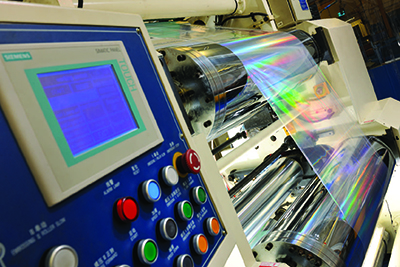Brand Packaging | Foils & Laminates Deliver Outstanding Benefits
- Published: November 03, 2017, By Bob Almer
Technological advances have made dazzling new effects possible.
 The first point of contact a customer has with any product is almost always its packaging. This makes it vital that packs catch the eye, especially in a crowded retail environment where there may be dozens of competitors sharing the same shelf space.
The first point of contact a customer has with any product is almost always its packaging. This makes it vital that packs catch the eye, especially in a crowded retail environment where there may be dozens of competitors sharing the same shelf space.
So how do brand managers ensure their products stand out from the crowd? As decorative foil packaging continues to advance, providing brands with breathtaking new solutions that until recently were unattainable, the answer is increasingly clear.
In recent years, technological advances have made an array of dazzling new effects in foil packaging possible, enabling brands to create ever more sophisticated pack solutions that provide consumers with a multi-sensory experience. For products that require strong shelf-appeal – such as luxury gifts, wine labels, and personal care goods – decorative foils, laminates, inks, and coatings have taken foil packaging to a new level.

For example, custom decorative holography services can offer specialist knowledge in the use of holography and 3D Designs, and inform customers how, as an integral part of the pack design, they can add the extra dimension to brands across a variety of sectors, from food to beauty.
The numbers don’t lie
We in the industry have long known that foils and holographics improve a product’s chances of attracting customers, but it’s only recently that we have been able to point to quantitative evidence to support this. A recent study by Package InSight at Clemson University, "Brand impact delivered through packaging," used state-of-the-art eye-tracking technology to uncover shoppers’ unconscious decision processes as they browse shelves on which some of the packs are foiled.

In a representative shopping environment, 70 participants wore special glasses while choosing luxury chocolate products from a shelf. The glasses tracked their eye movements in extreme detail, picking up on micro-signals that revealed why they favored certain products over others. Some products were foil stamped or laminated, while others featured no metallic embellishments.
The study found that, when faced with foiled and un-foiled versions of both Swiss and Belgian luxury chocolate packs, participants’ fixation counts were significantly higher for foiled packs than the un-foiled packs (p=0.13). It also found that, in the case of both the Swiss and Belgian offerings, participants’ fixation times were significantly longer for foiled than un-foiled packs (p=0.20). In short, embellished packs attracted shoppers' attention more often – and held it for longer – than unembellished packs.
Most importantly, Package InSight uncovered a strong correlation between fixation-time and product selection: the longer participants looked at a pack – and as we’ve established, foils and laminates extended this period – the more likely they were to purchase it.
Some insider tips
So foils deliver quantifiable benefit to brands, but what do we need to keep in mind when choosing them? Perhaps the most important thing – even more so than how much you love the shade – is to make sure it’s compatible with the substrate. Not all foils are suited to all surfaces. Having the correct foil will make the application run far smoother, whereas having an incompatible foil will result in a lot of preparation and press time and much wasted material.
Once you have the foil, you need to read its label to find out at what temperature it should be run. (Also, the temperature quoted on the label is what the die face temperature should be – this is very important to know.) Make sure you group each lot number together. This way, if there is an issue with the foil, you can always try a different lot number to see if the issue goes away.

Just as important as the foil is the equipment you are using. First and foremost, always make sure the press is in good working condition. If there are issues with the machine, the foil will under-perform. Also, in order to check that the foil is adhering to the substrate, the operator will require several tools. Scotch tape can be used for this important step – one that many converters neglect to perform – to see if it pulls the foil away. A set of dyne pens is essential. These will measure the surface tension to determine whether the substrate will accept foil. A good rule of thumb is that the surface temperature should be 40 dyne or higher.
The most common issue you are likely to face while foiling is that your foil won’t entirely cover the substrate. This is most often caused by not having enough heat, or else using an incompatible foil. Conversely, another problem you may find is that the foil covers the substrate too well, meaning it is filling in. This can happen when the temperature is too high or – again – if you are using the wrong foil, such as one designed to cover large areas.
No train, no gain
One of the biggest problems that operators have today is that companies are not training them to either run the press or use the foil. Many companies seem to think that these things can be learned overnight – something that is very far from the case. Even with decades of experience in the industry, it is still possible to learn something new every day, not least because the technology is evolving so fast.
“Training is, therefore, essential, and a converter should ideally select a foil vendor that offers a variety of training options in how to effectively work with foil. Your vendor should be willing to visit your facility and train your operators on-site (the benefit of which is that the converter learns while using their own equipment), or alternatively your operators can learn at your vendor's manufacturing facilities where they can see every step of the process and receive hands-on training on cutting-edge equipment.”
Delivering unrivaled expertise
The study by Package InSight clearly shows that foils and laminates significantly improve the chances of being purchased – but it’s important to understand that enhancements must be carefully integrated into the overall brand offering, and effectively applied, ensuring they work in harmony with every other aspect of the product. The right enhancements must be made to the right areas of the product, and the right product must be chosen for enhancement in the first place.
Today, the best packaging manufacturers work hard to ensure that brands working with their design teams benefit not only from their products but also their experience, attention, and skills. Experience in luxury products and packaging are used to spark innovation and aid brand evolution, identifying relevant trends and specifying the best approach for each individual customer.
Most purchasing decisions are made in the store – a fact that underlines the importance of standing out, but also the need to present a strong image in a brief window of time. By working closely with in-house design teams throughout the process to gain a profound understanding of the brand, packaging enhancements will complement the overall personality of the product. It is this ‘second skin’ approach to pack design – a winning fusion of technology and expertise used to truly represent the brand’s character through its packaging – that has become an irresistible proposition for today’s brands.
ABOUT THE AUTHOR

Bob Almer, VP of Sales at API Foils Inc., specializes in sales team leadership, key account management, and input for API’s custom decorative holography services Holonique Boutique. He has extensive experience in the packaging industry. API Group is a leading manufacturer and distributor of foils, laminates, and holographics with the goal of exceptional brand enhancement for consumer goods and printed media.












